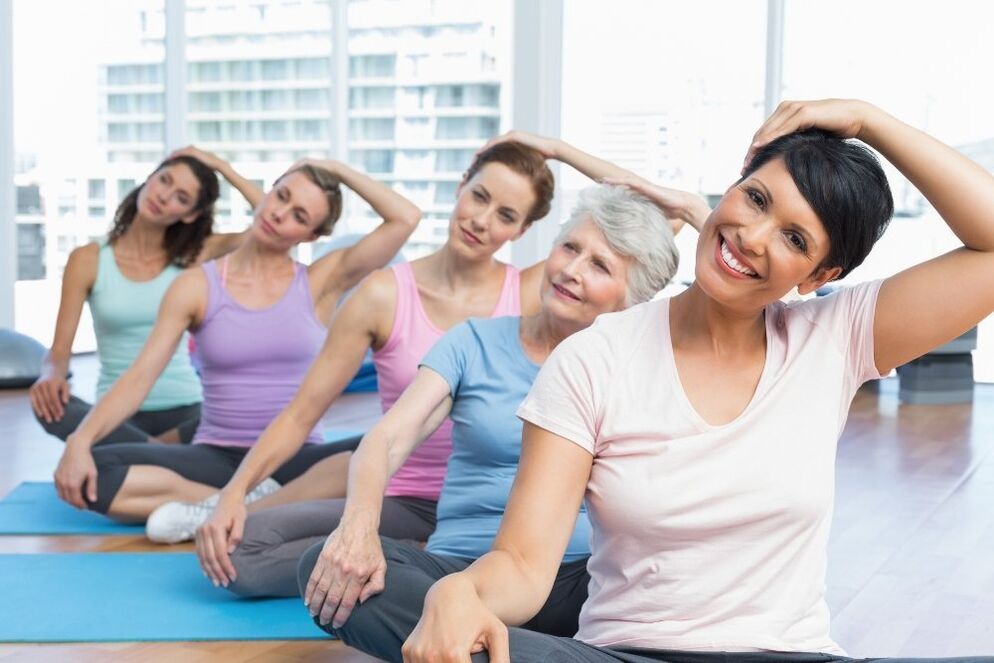Osteochondrosis of the neck is a disease characterized by pain in the appropriate area of the spine and is characterized by pathological changes in the intervertebral discs. They are most often confronted with people who lead a sedentary lifestyle and spend a lot of time in one position. One way of treatment is gym therapy. Those who are at risk but do not yet have such a diagnosis should follow preventive measures. Such departments require prior consultation with your doctor and recommendations.
Exercise at home or at work

Those who face such a diagnosis should take regular time to warm up the cervical vertebrae. Otherwise, this disease can develop into more serious health problems. There are exercises that can be done during breaks at work or at home in front of the TV:
- Lie on your back, put a small pillow under your head and press it with your head for 30 seconds. Then turn and press your forehead on the pillow for another 30 seconds.
- Lie on the bed with your neck and head over the edge. First lower your head, lying on your stomach, then your back, then repeat the same on the right and left.
- Sit on a chair with your hands lowered. The legs are slightly apart. Slowly but deeply tilt your head forward first, stretch your neck as far as possible and reach your chin to your chest. Then back, trying to touch the back of his head.
- In the same position, make circular movements with your shoulders, first forward and then backward. Try to perform the exercise with a large amplitude.
- Tilt your head first on your left shoulder and then on your right without changing position.
- Raise your hand, bend it at your elbow, and reach with your fingers to the opposite ear and pull your hand behind your head. Then do the same with the other hand.
- Sit with your back straight, tilt your head back, and reach to the appropriate shoulder with your ears, first on one side and then on the other.
- Keep your head straight, gently turning it first to the left and then to the right.
- Put your palm on your forehead and press it. In this case, the arm is motionless, resistance should only be felt in the muscles of the neck. Hold this for 20-30 seconds and do the same with the palm of your hand on the back of your head. You should then alternately press first on your right face and then your left.
- Get up, bend your head back, and gently bend your head forward, stretching your neck muscles.
- Touch your chin to your chest and gently turn your head left and right.
Each exercise should be performed in 5 repetitions in each direction. If their implementation is accompanied by pain, it should be supported manually.
Physical exercises of the medical complex

Practical therapy for cervical osteochondrosis includes the following physical exercises:
- Stand up or sit up straight, adjust your head so that your eyes are straight forward. Work only with your eyes. Look at them from left to right, in opposite directions, up and down, in different directions, rotate in a circle.
- Starting position - as in previous practice. First, turn your head left and right several times, then tilt your chin first to one shoulder and then to the other.
- Lie on your back, spread your arms sideways parallel to the floor surface, and turn your body to the side. When turning to the right, the left foot also goes to the right, and vice versa. When turning - exhale, when returning to the starting position - inhalation.
- Lie down, arms on your sides, legs straight. Sit down slowly, without sudden movements, and help yourself with your hands. Then take the starting position.
Such a diagnosis requires not only physical exercise related to a certain load, but also breathing:
- Stand up or lie on your back, put your hand on your stomach. Inhale slowly, inflate and inflate your stomach, and exhale even more slowly, pulling it in.
- Lie down, put one hand directly under your neck and the other under your chest. Take a breath and stretch your muscles. Then exhale - relaxation. Do it slowly and smoothly.
Perform all physical exercises 4-5 times and complete the complex as follows: grasp the supports with both hands, standing between them (two tables, two chairs); tie your feet up and rise to your toes. Rotate with your lower body first in one direction and then in the other. The body needs to relax.
Disease prevention

Prevention is always better than cure. But unfortunately no one thinks about it until the doctor makes a diagnosis. For those who spend a lot of time in a position, rarely move, and ignore the sport, follow these recommendations:
- Get up from work every hour, cross your palms on the back of your head, tie your shoulders together, and rotate your body left and right. When you turn around, you have to stop for a fraction of a second and then pick up the starting position. This should be done slowly, without sudden movements. Breathing is calm and deep.
- In the workplace, stretch your spine as often as possible and tilt left and right.
- You can do exercises on the floor at home without a mat. To do this, lie on your back and straighten your legs. Pull your right leg to the chest first, bending to your knees, and then to the left. In this case, you can clasp your feet with your hands and push them close to you.
- Get on your knees and bend your upper body towards the floor. Bend your back as far as possible, lift your neck and head, then round and push your forehead to the floor.
- After a day of work or training, you only need to lie on a hard, smooth surface for 10 minutes, completely relaxed. You can pull your legs up to your belly and hug them.
Such prevention can prevent not only the disease itself but also an exacerbation of an existing one. You should do this regularly, not from time to time. This will prevent sagging and neck pain.
It is desirable to perform the complexes shown in the same order, as the load is in ascending order. The first exercises are warm-ups and help you warm up and prepare your muscles for more severe loads.



































